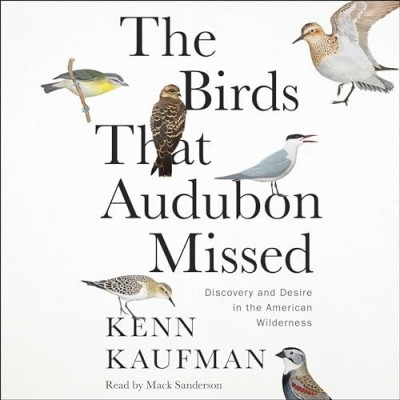The Birds That Audubon Missed: Discovery and Desire in the American Wilderness - [...
Dodał: 0dayddl
25.05.2024
Wyświetleń: 83
Коmentarzy: 0

Free Download The Birds That Audubon Missed: Discovery and Desire in the American Wilderness - [AUDIOBOOK]
mp3 | 332.67 MB | Author: Kenn Kaufman | Year: 2024
Description:
Renowned naturalist Kenn Kaufmanexamines the scientific discoveries of John James Audubon and his artistic and ornithologist peers to show how what they saw (and what they missed) reflects how we perceive and understand the natural world.
Raging ambition. Towering egos. Competition under a veneer of courtesy. Heroic effort combined with plagiarism, theft, exaggeration, and fraud. This was the state of bird study in eastern North America during the early 1800s, as a handful of intrepid men raced to find the last few birds that were still unknown to science.
The most famous name in the bird world was John James Audubon, who painted spectacular portraits of birds. But although his images were beautiful, creating great art was not his main goal. Instead, he aimed to illustrate (and write about) as many different species as possible, obsessed with trying to outdo his rival, Alexander Wilson. George Ord, a fan and protégé of Wilson, held a bitter grudge against Audubon for years, claiming he had faked much of his information and his scientific claims. A few of Audubon's birds were pure fiction, and some of his writing was invented or plagiarized. Other naturalists of the era, including Charles Bonaparte (nephew of Napoleon), John Townsend, and Thomas Nuttall, also became entangled in the scientific derby, as they stumbled toward an understanding of the natural world—an endeavor that continues to this day.
Despite this intense competition, a few species—including some surprisingly common songbirds, hawks, sandpipers, and more—managed to evade discovery for years. Here, renowned bird expert and artist Kenn Kaufman explores this period in history from a new angle, by considering the birds these people discovered and, especially, the ones they missed. Kaufman has created portraits of the birds that Audubon never saw, attempting to paint them in that artist's own stunning style, as a way of examining the history of natural sciences and nature art. He shows how our understanding of birds continues to gain clarity, even as some mysteries persist from Audubon's time until ours.
Raging ambition. Towering egos. Competition under a veneer of courtesy. Heroic effort combined with plagiarism, theft, exaggeration, and fraud. This was the state of bird study in eastern North America during the early 1800s, as a handful of intrepid men raced to find the last few birds that were still unknown to science.
The most famous name in the bird world was John James Audubon, who painted spectacular portraits of birds. But although his images were beautiful, creating great art was not his main goal. Instead, he aimed to illustrate (and write about) as many different species as possible, obsessed with trying to outdo his rival, Alexander Wilson. George Ord, a fan and protégé of Wilson, held a bitter grudge against Audubon for years, claiming he had faked much of his information and his scientific claims. A few of Audubon's birds were pure fiction, and some of his writing was invented or plagiarized. Other naturalists of the era, including Charles Bonaparte (nephew of Napoleon), John Townsend, and Thomas Nuttall, also became entangled in the scientific derby, as they stumbled toward an understanding of the natural world—an endeavor that continues to this day.
Despite this intense competition, a few species—including some surprisingly common songbirds, hawks, sandpipers, and more—managed to evade discovery for years. Here, renowned bird expert and artist Kenn Kaufman explores this period in history from a new angle, by considering the birds these people discovered and, especially, the ones they missed. Kaufman has created portraits of the birds that Audubon never saw, attempting to paint them in that artist's own stunning style, as a way of examining the history of natural sciences and nature art. He shows how our understanding of birds continues to gain clarity, even as some mysteries persist from Audubon's time until ours.
Download Link:
Aby zobaczyć ukryty tekst, musisz być zalogowany. Jeżeli nie masz konta, zarejestruj się!
Aby zobaczyć ukryty tekst, musisz być zalogowany. Jeżeli nie masz konta, zarejestruj się!
DODAJ KOMENTARZ
Informacja
Członkowie grupy Gość nie posiadają uprawnień do komentowania tego artykułu.

KOMENTARZE (0)